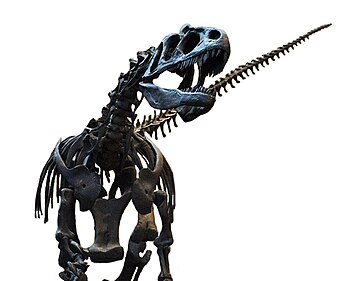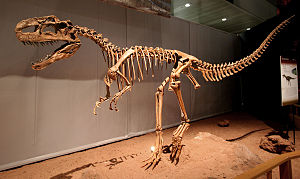Joanusaurid
| Joanusauroidae | |
|---|---|

| |
| Mounted Joanusaurus | |
| Scientific classification | |
| Kingdom: | |
| Phylum: | |
| Class: | |
| Order: | |
| Family: | Joanusauroidae Thibault d'Avignon, 1878
|
The joanusauroidae or joanusaurids (meaning "Joanus' lizards") was a superfamily or clade of theropod dinosaurs. The joanusaurids are thought to have been among the apex predators that were active on the supercontinent Sarpolevantia from the Middle Jurassic to the Late Cretaceous periods c. 175-65 million years ago. Paleontologists agree that Projoanusaurus (literally "before Joanusaurus") is the earliest known joanusauroid, though some suspect earlier more basal joanusauroids may have existed but are yet to be discovered from the sparse Middle Jurassic sediments of eastern Sarpedon and southern Levantia. True joanusaurids (joanusauridae) split off from the clade sarponychidae at some point during the Late Jurassic, at which time the two families diversified immensely. The most recent common ancestor of joanusauridae and sarponychidae is thought to have been Magnalophosaurus. The last known living member of the joanusaurids was Levaretyrannus whose fossilized remains have been found in central and western Levantia in sediments dating to the Cretaceous–Paleogene extinction event c. 65.5 million years ago, during which more than 75% of all species died out including all non-avian dinosaurs.
Like most theropods, joanusaurids were carnivorous bipeds. They were characterized by stocky hind limbs and extensive ornamentation of the skull bones, with grooves and pits. Joanusaurids would have differed widely in size, with early genera from the Middle Jurassic such as Projoanusaurus measuring around 3-4 meters (10-13 ft) in length up to the likes of Vollardisaurus and Kubantadens of the Cretaceous period reaching lengths of about 14.5 meters (47.6 ft) and the Levaretyrannus known to have reached 15.2 m (50 ft) in total. Similarly, mass estimates for joanusauroids range from the smallest taxa Projoanusaurus estimated at 50–100 kg (110–220 lb) to Levaretyrannus estimated at 5–8 tonnes, placing it among the heaviest theropods behind the largest caphirosaurids like Caphirosaurus.
Joanusauroids are thought to have entirely dominated the supercontinent Sarpolevantia as apex predators during the Middle and Late Jurassic. By the Late Jurassic, the joanusaurids and sarponychidae diversified, with joanusauridae remaining chiefly in what is today central and western Levantia and the sarponychidae in Sarpedon. The decline of the sarponychidae is thought to have been the catalyst for the rise of the caphirosaurids in Sarpedon, with paleontologists generally agreeing the decline of the sarponychidae opened an evolutionary niche for another family of large theropods.
Phylogeny

Joanusauroids are today defined as a clade as "All neotetanurans closer to Joanusaurus than to Neornithes". While paleontologists have long recognized the family joanusauridae, its ancestry has been the subject of much debate. For most of the twentieth century, caphirosaurids were commonly accepted as members of the joanusauridae as part of Carnosauria, which included almost all large theropods. Within this group, the joanusaurids were often considered to be ancestral to caphirosaurids. Cladistic analyses from the 1980s instead replaced caphirosaurids into the Coelurosauria, echoing speculation from the early twentieth century from notable paleontologists like Phillipe d'Everard and Jour & Leon.
| Joanusauroidae |
| ||||||||||||||||||||||||||||||||||||||||||||||||||||||||||||||||||
Description

Joanusauroids share certain distinctive features, one of which is a triangular-shaped pubic boot. Joanusauroids have 3 fingers per hand, with the second and third digit being approximately equal in length. The femur is larger than the tibia. Another defining feature of joanusauroids is that the chevron bases on their tails have anterior and posterior bone growth. The body of joanusauroids can reach up to 10 meters in length; the length of the body from the tail to the hip is between 54% and 62% of the total body length, and the length of the body from the head to the hip is between 38% and 46% of the total body length. Joanusauroids scaled their limbs relative to their body in a way similar to how other large theropods, like the caphirosaurids, did. During the Cretaceous, some joanusauroids grew to sizes similar to those of the largest caphirosaurids. A notable example is the Late Cretaceous Levaretyrannus which is thought to have rivaled even Caphirosaurus in size.
Other similarities across all joanusauroids include the structure of their hind limb and pelvis. The pelvis in particular is thought to be designed to reduce stress regardless of body size. In particular, the way the femur is inclined reduces the bending and torsion stress. Furthermore, like other animals with tails, joanusauroids possess a caudofemoralis longus (CFL) muscle that allowed them to flex theirs. Larger joanusauroids are found to have a lower CFL muscle-to-body-mass proportion than smaller joanusauroids.
In addition to body similarities, joanusauroids are also united by certain skull features. Early joanusauroids had ornamental head crests on top of their skulls as tools of socio-sexual display. These head crests would go on to evolve into ridges over the eyes of the later true joanusauridae. Some of the other defining skull features include a smaller mandibular fenestra, a short quadrate bone, and a short connection between the braincase and the palate. Joanusauroid skulls are about 2.5 to 3 times longer than they are tall. Their narrow skull along with their serrated teeth allow joanusauroids to better slice flesh off of their prey.
Paleobiology

Multiple severe injuries have been found on joanusauroid remains, which implies that joanusauroids were frequently in dangerous situations and supports the hypothesis of an active, predatory lifestyle. Despite the multitude of injuries, only a few of those injuries show signs of infection (a notable exception being the Joanusaurus Big Yon). For those injuries that did become infected, the infections were usually local to the site of the injury, implying that the joanusauroid immune response was able to quickly stop any infection from spreading to the rest of the body. This type of immune response is similar to modern reptilian immune responses; reptiles secrete fibrin near infected areas and localize the infection before it can spread via the bloodstream.
The injuries were also found to be mostly healed. This healing may indicate that joanusauroids had an intermediate metabolic rate, similar to non-avian reptiles, which means they require fewer nutrients in order to survive. A lower nutrient requirement means joanusauroids do not need to undertake frequent hunts, which lowers their risk of sustaining traumatic injuries.
Although the remains of other large theropods like caphirosaurids bear evidence of fighting within their species and with other predators, the remains of joanusauroids do not bear much evidence of injuries from theropod combat. Most notably, despite a good fossil record, joanusauroid skulls lack the distinctive face-biting wounds that are common in caphirosaurids skulls, leaving open the question of if joanusauroids engaged in interspecies and intraspecies fighting. Joanusauroid remains are also often found in groups, which implies social behavior. While there are alternative explanations for the groupings, like predator traps or habitat reduction due to drought, the frequency of finding joanusauroid remains in groups supports the social animal theory. As social animals, joanusauroids would share the burden of hunting, allowing injured members of the pack to recover faster.






